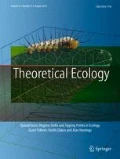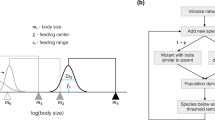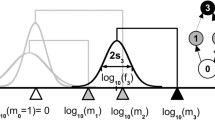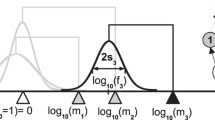Abstract
Ecological communities emerge as a consequence of gradual evolution, speciation, and immigration. In this study, we explore how these processes and the structure of the evolved food webs are affected by species-level properties. Using a model of biodiversity formation that is based on body size as the evolving trait and incorporates gradual evolution and adaptive radiation, we investigate how conditions for initial diversification relate to the eventual diversity of a food web. We also study how trophic interactions, interference competition, and energy availability affect a food web’s maximum trophic level and contrast this with conditions for high diversity. We find that there is not always a positive relationship between conditions that promote initial diversification and eventual diversity, and that the most diverse food webs often do not have the highest trophic levels.



Similar content being viewed by others
References
Abrams PA (1993) Effect of increased productivity on the abundances of trophic levels. Am Nat 141:351–371
Abrams PA (1997) Evolutionary responses of foraging-related traits in unstable predator-prey systems. Evol Ecol 11:673–686
Adams SM, Kimmel BL, Ploskey GR (1983) Sources of organic matter for reservoir fish production: a trophic-dynamics analysis. Can J Fish Aquat Sci 40:1480–1495
Bastolla U, Lässig M, Manrubia SC, Valleriani A (2005) Biodiversity in model ecosystems, ii: species assembly and food web structure. J Theor Biol 235:531–539
Bergelson J, Dwyer G, Emerson J (2001) Models and data on plant-enemy coevolution. Annu Rev Genet 35:469–499
Brose U, Osling A, Harrison K, Martinez ND (2004) Unified spatial scaling of species and their trophic interactions. Nature 428:167–171
Buckling A, Rainey PB (2002a) Antagonistic coevolution between a bacterium and a bacteriophage. Proc R Soc Lond B 269:931–936
Buckling A, Rainey PB (2002b) The role of parasites in sympatric and allopatric host diversification. Nature 420:496–499
Caldarelli G, Higgs P, McKane A (1998) Modelling coevolution in multispecies communities. J Theor Biol 193:345–358
Cattin M, Bersier L, Banasek-Richter C, Baltensperger R, Gabriel J (2004) Phylogenetic constraints and adaptation explain food web structure. Nature 427:835–839
Chase JM, Leibold MA (2002) Spatial scale dictates the productivity-biodiversity relationship. Nature 416:427–430
Christensen K, di Collobiano SA, Hall M, Jensen HJ (2002) Tangled nature: a model of evolutionary ecology. J Theor Biol 216:73–84
Cohen J, Briand F, Newman C (1990) Community food webs: data and theory. Springer Verlag, Berlin
Díaz S, Cabido M (2001) Vive la différence: plant functional diversity matters to ecosystem processes. Trends Ecol Evol 16:646–655
Dieckmann U, Law R (1996) The dynamical theory of coevolution: a derivation from stochastic ecological processes. Trends Ecol Evol 34:579–612
Drake JA (1990) The mechanics of community assembly and succession. J Theor Biol 147:213–233
Drossel B, Higgs P, McKane A (2001) The influence of predator-prey population dynamics on the long-term evolution of food web structure. J Theor Biol 208:91–107
Friesen M, Saxer G, Travisano M, Doebeli M (2004) Experimental evidence for sympatric ecological diversification due to frequency-dependent competition in Escherichia coli. Evolution 58(2):245–260
Geritz SAH, Kisdi E, Meszéna G, Metz JAJ (1998) Evolutionary singular strategies and the adaptive growth and branching of the evolutionary tree. Evol Ecol 12:35–57
Gillespie JH (2004) Population genetics: a concise guide. The John Hopkins University Press
Grimmett GR, Stirzaker DR (1992) Probability and random processes, 2nd edn. The Clarendon Press Oxford University Press, New York
Habets MGJL, Rozen DE, Hoekstra RF, Arjan J, De Visser AGM (2006) The effect of population structure on the adaptive radiation of microbial populations evolving in spatially structured environments. Ecol Lett 9:1041–1048
Hector A, Schmid B, Beierkuhnlein C, Caldeira MC, Diemer M, Dimitrakopoulos PG, Finn JA, Freitas H, Giller PS, Good J, Harris R, Högberg P, Huss-Danell K, Joshi J, Jumpponen A, Körner C, Leadley PW, Loreau M, Minns A, Mulder CPH, O’Donovan G, Otway SJ, Pereira JS, Prinz A, Read DJ, Scherer-Lorenzen M, Schulze ED, Siamantziouras ASD, Spehn EM, Terry AC, Troumbis AY, Woodward FI, Yachi S, Lawton JH (1999) Plant diversity and productivity experiments in european grasslands. Science 286:1123–1127
Hofbauer J, Sigmund K (1998) Evolutionary games and population dynamics. Cambridge University Press, Cambridge, UK
Hooper DU, Chapin FS, Ewel JJ, Hector A, Inchausti P, Lavorel S, Lawton JH, Lodge DM, Loreau M, Naeem S, Schmid B, Setl H, Symstad AJ, Vandermeer J, Wardle DA (2005) Effects of biodiversity on ecosystem functioning: a consensus of current knowledge. Ecol Monogr 75:3–35
Ito HC, Dieckmann U (2007) A new mechanism for recurrent adaptive radiations. Am Nat 170:E96–E111
Ito HC, Ikegami T (2006) Food-web formation with recursive evolutionary branching. J Theor Biol 238:1–10
Ives AR, Klug JL, Gross K (2000) Stability and species richness in complex communities. Ecol Lett 3:399–411
Jansen VAA, Kokkoris GD (2003) Complexity and stability revisited. Ecol Lett 6:498–502
Jennings S, Warr KJ (2003) Smaller predator-prey size ratios in longer food chains. Proc R Soc Lond B 270:1413–1417
Kassen R, Rainey PB (2004) The ecology and genetics of microbial diversity. Annu Rev Microbiol 58:207–231
Kinzig AP, Pacala SW, Tilman D (eds) (2001) The functional consequences of biodiversity: empirical progress and theoretical extensions. Princeton University Press
Klak C (2004) Unmatched tempo of evolution in southern african semi-desert ice plants. Nature 427:63–65
Kondoh M (2003) Foraging adaptation and the relationship between food-web complexity and stability. Science 299:1388–1391
Law R, Morton D (1996) Permanence and the assembly of ecological communities. Ecology 77(3):762–775
Loeuille N, Loreau M (2009) Emergence of complex food web structure in community evolution models. In: Verhoef HA, Morin PJ (eds) Community ecology, Oxford University Press
Loeuille N, Loreau M (2005) Evolutionary emergence of size structured food webs. Proc Natl Acad Sci USA 102(16):5761–5766
Loeuille N, Loreau M, Ferrière R (2002) Consequences of plant-herbivore coevolution on the dynamics and functioning of ecosystems. J Theor Biol 217:369–381
Loreau M, Naeem S, Inchausti P, Bengtsson J, Grime JP, Hector A, Hooper DU, Huston MA, Raffaelli D, Schmid B, Tilman D, Wardle DA (2001) Biodiversity and ecosystem functioning: current knowledge and future challenges. Science 294:804–808
Loreau M, Naeem S, Inchausti P (eds)(2002) Biodiversity and ecosystem functioning: synthesis and perspectives. Oxford University Press
Macarthur RH, Wilson EO (2001) The theory of island biogeography. Princeton University Press
Massin N, Gonzalez A (2006) Adaptive radiation in a fluctuating environment: disturbance affects the evolution of diversity in a bacterial microcosm. Evol Ecol Res 8:471–481
May RM (1972) Will a large complex system be stable? Nature 238:413–414
McKane AJ (2004) Evolving complex food webs. Eur Phys J B 38:287–295
McLean RC, Dickson A, Bell G (2005) Resource competition and adaptive radiation in a microbial microcosm. Ecol Lett 8:38–46
Morton D, Law R (1997) Regional species pools and the assembly of local ecological communities. J Theor Biol 187:321–331
Naeem S, Thompson LJ, Lawler SP, Lawton JH, Woodfin RM (1994) Declining biodiversity can alter the performance of ecosystems. Nature 368:734–737
Naeem S, Bunker DE, Hector A, Loreau M, Perrings C (eds) (2009) Biodiversity, ecosystem functioning, and human wellbeing: an ecological and economic perspective. Oxford University Press
Nosil P, Crespi BJ (2006) Experimental evidence that predation promotes divergence in adaptive radiation. Proc Natl Acad Sci USA 103:9090–9095
Odum WE, Heald EJ (1975) The detritus-based food web of an estuarine mangrove community. In: Cronin L (ed) Estuarine research. Chemistry biology and the estuarine system, vol 1, Academic Press, London
Oksanen L, Fretwell SD, Arruda J, Niemela P (1981) Exploitation ecosystems in gradients of primary productivity. Am Nat 118:240–261
Persson L, Diehl S, Johansson L, Hamrin SF (1992) Interactions in temperate lake ecosystems: a test of food chain theory. Am Nat 140:59–84
Peters RH (1983) The ecological implications of body size. Press Syndicate of the University Of Cambridge, Cambridge, UK
Pimm SL, Lawton JH (1977) The number of trophic levels in ecological communities. Nature 268:329–331
Post DM, Pace ML, Hairston NGJ (2000) Ecosystem size determines food chain length in lakes. Nature 405:1047–1049
Post WM, Pimm SL (1983) Community assembly and food web stability. Math Biosci 64:169–192
Press WH, Teukolsky SA, Vetterling WT, William Y, Flannery BP (1992) Numerical recipes in C, 2nd edn. Cambridge University Press, Cambridge, the art of scientific computing
Rainey PB, Travisano M (1998) Adaptive radiation in a heterogeneous environment. Nature 394:69–73
Rosenzweig ML (1995) Species diversity in space and time. Cambridge University Press
Rossberg AG, Matsuda H, Amemiya T, Itoh K (2005) An explanatory model for food-web structure and evolution. Ecological Complexity 312:312–321
Rossberg AG, Matsuda H, Amemiya T, Itoh K (2006) Food webs: experts consuming families of experts. J Theor Biol 241:552–563
Rossberg AG, Ishii R, Amemiya T, Itoh K (2008) The top-down mechanism for body mass–abundance scaling. Ecology 89(2):567–580
Saloniemi I (1993) A coevolutionary predator-prey model with quantitative characters. Am Nat 141(6):880–896
Steiner CF, Leibold MA (2004) Cyclic assembly trajectories and scale-dependent productivity-diversity relationship. Ecology 85:107–113
Stocks R, McPeek MA (2006) A tale of two diversifications: reciprocal habitat shifts to fill ecological space along the pond permanence gradient. Am Nat 168:50–72
Tilman D, Wedin D, J K (1996) Productivity and sustainability influenced by biodiversity in grassland ecosystems. Nature 379:718–720
Tokita K, Yasutomi A (2006) Emergence of a complex and stable network in a model ecosystem with extinction and mutation. Theor Popul Biol 63:131–146
Williams RJ, Martinez ND (2000) Simple rules yield complex food webs. Nature 404:180–183
Worm B, Duffy JE (2003) Biodiversity, productivity and stability in real food webs. Trends Ecol Evol 18(12):628–632
Yodzis P (1989) Introduction to theoretical ecology. Harper & Row
Yoshida K (2003) Dynamics of evolutionary patterns of clades in a food web system model. Ecol Res 18:625–637
Acknowledgements
We thank Hiroshi C. Ito, Jacob Johansson, Shovonlal Roy, and Jack Teng for valuable comments and suggestions. This research has been supported by the European Marie Curie Research Training Network FishACE (Fisheries-induced Adaptive Changes in Exploited Stocks), funded through the European Community’s Sixth Framework Programme (Contract MRTN-CT-2004-005578). In addition, Å. B. gratefully acknowledges support by the Swedish Kempe Foundations and the Japan Society for the Promotion of Science. U. D. gratefully acknowledges support by the European Science Foundation, the Austrian Science Fund, and the Vienna Science and Technology Fund. Michel Loreau gratefully acknowledges support by the Natural Sciences and Engineering Research Council of Canada and the Canada Research Chairs program.
Author information
Authors and Affiliations
Corresponding author
A Appendix
A Appendix
A.1 Evolutionary dynamics
To increase computational efficiency, we have implemented the evolutionary process such that for any community of coexisting morphs we draw the next successfully invading mutant trait value and the time at which the invasion occurs.
A.1.1 Determining the rate of successful mutations
We first determine the probability p i that a mutant in morph i is successful. Recalling that we assume a mutant’s trait value to be normally distributed with variance \(\sigma_m^2\) around its parent’s trait value, and denoting by p r (m) the probability that a mutant with trait value m successfully invades a community characterized by the trait values r = (r 1, ..., r n ) of the resident morph, p i is given by
where ϕ is the probability density function of the standard normal distribution. In general, this integral would have to be evaluated numerically, but for small values of σ m , a second-order Taylor approximation of p r (m) around r i can be used. With τB i denoting the rate at which mutations occur in morph i, the rate at which successful mutations occurs in morph i is s i = τB i p i .
A.1.2 Drawing the next successful mutant
The morph i in which the next successful mutant occurs is drawn with probability s i /S, with S = ∑ i s i . We then draw the mutant’s trait value m from the probability density function
To do this, we use the rejection method described in Press et al. (1992). After choosing a sufficiently large maximal value D of the deviation |m − r i |, and after determining an upper bound F m so that F(m) > fm for all m, we draw a uniformly distributed bivariate random deviate (m, y) with |m − r i | < D and y < F m . If y < f(m), we take m as the new mutant trait value; otherwise, the bivariate random draw is repeated. Alternatively, we can draw m from the normal distribution σ((m − r i )/σ m )/σ m and y from the uniform distribution over the unit interval. If y < p r (m), we take m as the new mutant trait value; otherwise, the bivariate random draw is repeated.
Finally, since the arrival of successful mutants follows a Poisson process with intensity S, the waiting time between such events is drawn from an exponential distribution with parameter S (see e.g. Grimmett and Stirzaker 1992, pp 248).
A.1.3 Implementing the oligomorphic stochastic model
The evolutionary dynamics of the oligomorphic stochastic model (Ito and Dieckmann 2007) are obtained by assuming a time-scale separation between population dynamics and evolutionary dynamics and by making a simplifying assumption for the conditions under which a mutant trait value replaces the resident trait value from which it arises. Specifically, we implemented a variant of the oligomorphic stochastic model that considers a community viable if the corresponding system of Lotka-Volterra equations has an interior rest point (see Hofbauer and Sigmund (1998) for a thorough account of the relationship between Lotka-Volterra dynamics and the existence of interior rest points).
It is worth noting that the method described by Law and Morton (1996) for species-assembly models based on Lotka-Volterra dynamics in particular, the use of permanence to determine a community’s viability can possibly be adapted to evolutionary models based on Lotka-Volterra dynamics, which would enable an improvement over the algorithm described here.
A.2 Definition of trophic levels
Although the concept of trophic level is frequently encountered in the literature, it is not always easy to define. Most of the proposed methods (see Yodzis 1989 for examples) are either difficult to apply to food webs containing cycles and loops, or expensive to calculate in practice. Furthermore, if trophic levels are defined as taking integer values only, the implied abrupt jumps in trophic level will make it difficult to track the dynamics of evolving food webs.
Following Odum and Heald (1975) and Adams et al. (1983), we define a morphs’ real-valued fractional trophic level as 1 plus the average trophic level of its prey. Denoting by t i the fractional trophic level of morph i = 0,...,n (with t 0 = 1 corresponding to the basal autotrophic resource) and by v ij the proportion of energy entering morph i from morph j (with ∑ j v ij = 1), the fractional trophic levels t i are defined as the solutions of the linear equations
Rights and permissions
About this article
Cite this article
Brännström, Å., Loeuille, N., Loreau, M. et al. Emergence and maintenance of biodiversity in an evolutionary food-web model. Theor Ecol 4, 467–478 (2011). https://doi.org/10.1007/s12080-010-0089-6
Received:
Accepted:
Published:
Issue Date:
DOI: https://doi.org/10.1007/s12080-010-0089-6




